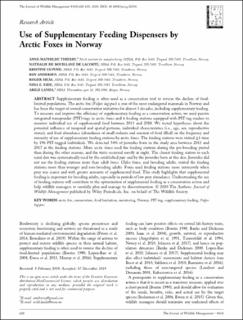Use of Supplementary Feeding Dispensers by Arctic Foxes in Norway
Thierry, Anne-Mathilde; De Lacoste, Nathalie; Ulvund, Kristine R.; Andersen, Roy; Meås, Roger; Eide, Nina Elisabeth; Landa, Arild Magne
Peer reviewed, Journal article
Published version

Åpne
Permanent lenke
https://hdl.handle.net/11250/2728097Utgivelsesdato
2020Metadata
Vis full innførselSamlinger
- Publikasjoner fra CRIStin - NINA [2364]
- Scientific publications [1392]
Sammendrag
Supplementary feeding is often used as a conservation tool to reverse the decline of food‐limited populations. The arctic fox (Vulpes lagopus) is one of the most endangered mammals in Norway and has been the target of several conservation initiatives for almost 3 decades, including supplementary feeding. To measure and improve the efficiency of supplementary feeding as a conservation action, we used passive integrated transponder (PIT)‐tags in arctic foxes and 6 feeding stations equipped with PIT‐tag readers to monitor individual use of supplemental food between 2013 and 2018. We tested hypotheses about the potential influence of temporal and spatial patterns, individual characteristics (i.e., age, sex, reproductive status), and food abundance (abundance of small rodents and amount of food filled) on the frequency and intensity of use of supplementary feeding stations by arctic foxes. The feeding stations were visited ≥1 time by 196 PIT‐tagged individuals. We detected 54% of juveniles born in the study area between 2013 and 2017 at the feeding stations. More arctic foxes used the feeding stations during the pre‐breeding period than during the other seasons, and the visits occurred mostly at night. The closest feeding station to each natal den was systematically used by the established pair and by the juveniles born at this den. Juveniles did not use the feeding stations more than adult foxes. Older foxes, and breeding adults, visited the feeding stations more than younger and non‐breeding adults. Foxes used feeding stations more intensively when prey was scarce and with greater amounts of supplemental food. This study highlights that supplemental feeding is important for breeding adults, especially in periods of low prey abundance. Understanding the use of feeding stations will contribute to the optimization of supplemental feeding as a conservation action and help wildlife managers to carefully plan and manage its discontinuation.
